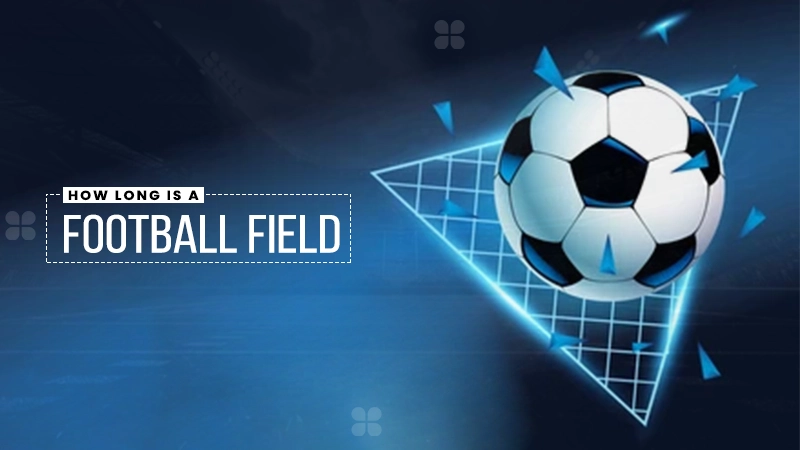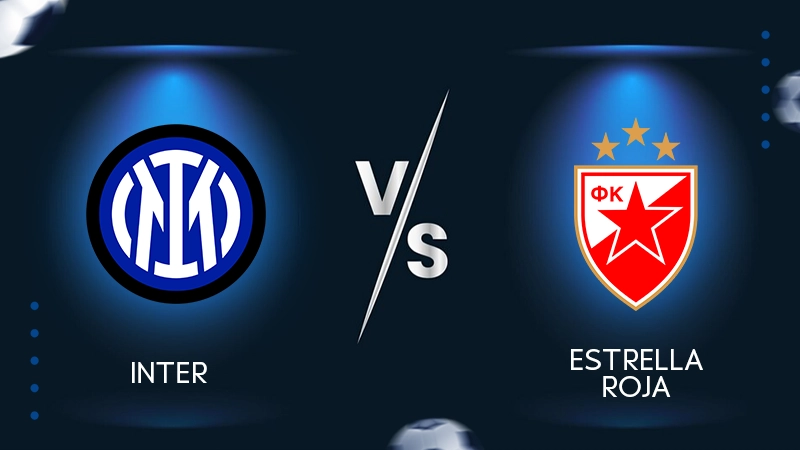If you’ve ever tried to understand play design, coaching strategies, or stadium layouts, one question always appears first: how long is a football field?
While most fans know the field is “100 yards,” the real story goes deeper. A full American football field is a carefully engineered structure with exact measurements in yards, feet, and meters, standardized markings, and rule-driven variations between the NFL, NCAA, and High School levels.
Coaches rely on these measurements to script plays, grounds crews use them to mark the turf accurately, and students and fans use them to visualize how the sport actually works. This guide breaks down every part of the field with simple explanations and advanced insights so you can easily visualize the layout.
Let’s get started!
- Exact Dimensions — How Long Is a Football Field?
- Football Field Layout — Every Section Explained
- Exact Hash Mark Measurements — Biggest Rule Difference
- The Field in Feet, Yards & Meters (Quick Reference Chart)
- NFL vs NCAA vs High School — Full Comparison
- How a Football Field Is Measured & Marked
- History of Football Field Dimensions
- Interesting Facts About Football Field Length
- Common Misunderstandings
- Conclusion
- FAQs
Exact Dimensions — How Long Is a Football Field?
A standard American football field has two main length measurements:
1. Field of Play
- 100 yards long
- 300 feet
- 91.44 meters
This is the distance between the two goal lines.
2. Full Length Including End Zones
Each end zone is 10 yards deep, so:
- 100 yards field of play
- + 20 yards of end zones
= 120 yards total length
In conversions:
- 360 feet total
- 109.728 meters
3. Width
Across all major levels (NFL, NCAA, HS), the field width is the same:
- 53⅓ yards
- 160 feet
- 48.768 meters
This full width plays a huge role in play-calling, spacing concepts, and defensive coverage.
Read More: What is DB in Football?
Football Field Layout — Every Section Explained
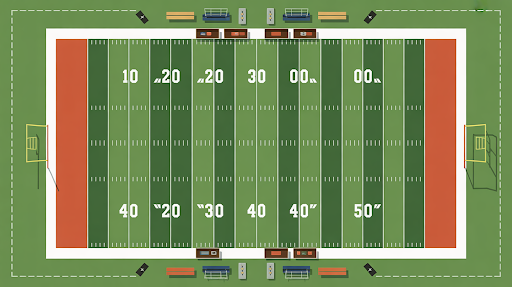
To fully understand “how long is a football field,” you must break it down into its components. Each section serves a specific gameplay or safety purpose.
A. Field of Play (100 yards)
This is the main action zone. Drives, passes, runs, and defensive formations all happen here. The 100-yard space is divided by yard lines that help coaches organize plays precisely.
B. End Zones (10 yards each)
Beyond each goal line is a 10-yard-deep scoring area.
Their full dimension:
- 10 yards × 160 feet
End zones host touchdowns, two-point conversions, and fumbles or interceptions returned for scores.
C. Goal Lines
These run across the width of the field at each end of the 100-yard section.
Crossing the goal line with the ball results in a touchdown.
D. End Lines
Behind each end zone, 10 yards further, lies the end line the final out-of-bounds limit.
E. Sidelines
The long boundary markings on each side of the field.
Stepping on or over them means the player is out of bounds.
F. Yard Lines & Markers
- A full line every 5 yards
- Short tick marks every 1 yard
- Big numbers painted at 10, 20, 30, 40, and 50
These markers help players align formations and allow referees to determine ball placement.
G. Hash Marks
These are one of the most important parts of the field and one of the biggest differences between levels of play.
Hash marks determine where the ball is placed after each play that ends between the sidelines.
H. Team & Coaching Boxes
On each sideline:
- Player bench area
- Coaching box
- Designated warm-up zone
These zones are strictly measured to prevent crowding and maintain order during games.
I. Safety Zones (Runoff Area)
Beyond the sidelines and end lines is usually a minimum 6–12 feet safety zone.
This protects players from hitting obstacles when momentum carries them out of bounds and it’s an important factor when understanding how long is a football field including the additional runoff space required for player safety.
Exact Hash Mark Measurements — Biggest Rule Difference
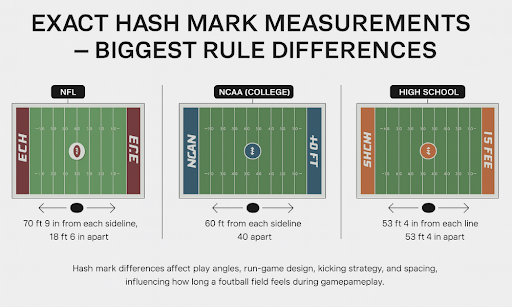
Though field length and width stay the same across levels, hash marks differ significantly. These differences affect play angles, run-game design, kicking strategy, and defensive alignment.
NFL Hash Marks
- 70 feet 9 inches from the sidelines
- Distance between NFL hash marks: 18 feet 6 inches
This narrow spacing pulls the ball toward the center of the field, creating balanced angles for both sides of the offense.
NCAA (College) Hash Marks
- 60 feet from each sideline
- Distance between college hash marks: 40 feet
This spacing encourages wider formations and benefits teams with strong run-heavy or misdirection offenses.
High School Hash Marks
- 53 feet 4 inches from each sideline
- Distance between hash marks: 53 feet 4 inches
High-school hashes are the widest, pushing many plays toward the nearest sideline and creating naturally tougher kick angles which also influences how long is a football field feels in terms of spacing and strategy.
The Field in Feet, Yards & Meters (Quick Reference Chart)
| Area | Yards | Feet | Meters |
| Field of Play | 100 | 300 | 91.44 m |
| End Zone | 10 | 30 | 9.144 m |
| Total Length | 120 | 360 | 109.728 m |
| Width | 53⅓ | 160 | 48.768 m |
| Sideline to Hash (NFL) | — | 70’9″ | 21.56 m |
| Hash to Hash (NFL) | — | 18’6″ | 5.64 m |
This chart offers a rapid reference in terms of the measurements of an American football field expressed in yards, feet, and meters. It contains field lengths, widths, end-zone lengths, and critical distances of NFL hash-marks just in case of field arrangements, layout or comparative field dimensions.
NFL vs NCAA vs High School — Full Comparison
| Feature | NFL | NCAA (College) | High School |
| Total Length | 120 yards | 120 yards | 120 yards |
| Field of Play | 100 yards | 100 yards | 100 yards |
| Width | 160 ft | 160 ft | 160 ft |
| End Zone Depth | 10 yards | 10 yards | 10 yards |
| Hash to Sideline | 70’9″ | 60 ft | 53’4″ |
| Hash to Hash | 18’6″ | 40 ft | 53’4″ |
| Goalpost Width | 18’6″ | 18’6″ | Often 18’6″ (can vary) |
| Number Size | Standard NFL stencil | Standard NCAA | Varies by state |
| Primary Impact | Balanced center play | Wide formation options | Sideline-heavy play angles |
A. Length and Width
- All levels: 100-yard field of play
- All levels: 10-yard end zones
- All levels: 160-foot width
No changes here universal standardization keeps football consistent.
B. Hash Marks
This is the most important difference:
- NFL: Narrowest
- NCAA: Medium
- High School: Widest
These differences affect:
- Run angles
- Field-goal difficulty
- Punt placement
- Offensive spacing
- Sideline play design
C. Numbers & Field Markings
- NFL and NCAA use similar marking sizes
- High schools often use simplified or larger stencils
- Arrows, conference logos, and sponsor markings vary by league rules
D. Goalposts
High School: Often the same, but sometimes wider depending on the region
NFL & NCAA: 18 ft 6 in width
How a Football Field Is Measured & Marked?
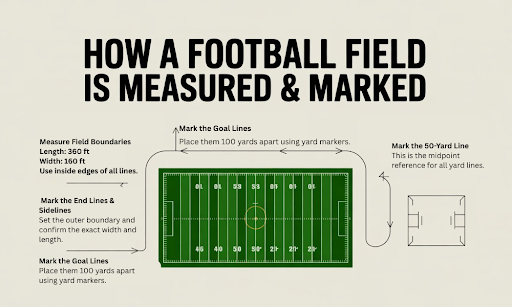
Marking a field is a precise process used by grounds crews, stadium staff, and school coaches, especially when defining measurements that show exactly how long is a football field.
Step 1: Measure the Field Boundaries
Crews measure:
- Length (360 ft)
- Width (160 ft)
- End lines and sidelines
Measurements always use inside edges of lines.
Step 2: Mark the 50-yard Line
This establishes the midpoint and becomes the reference for all other yard lines.
Step 3: Lay Out the Goal Lines & End Zones
- 10 yards back from each end line
- End zone art and goalpost alignment begins here
Step 4: Add Yard Lines
Every 5 yards across the width of the field.
Step 5: Add Hash Marks
Spacing depends on the level (NFL, NCAA, HS).
Step 6: Paint Numbers & Logos
Numbers usually measure:
- 6 ft high
- 4 ft wide
Step 7: Create Safety Zones
A 6–12 foot buffer outside the boundaries protects players.
This is why high-quality fields require exact geometry and professional tools like laser measures and precision wheels.
History of Football Field Dimensions
Early Gridiron Origins
American football evolved from rugby in the late 1800s. Fields weren’t always 100 yards long early versions used rugby dimensions or hybrid lengths, which makes it interesting when comparing how long is a football field today versus the sport’s early days.
Standardization in the 1910s–1920s
As rules developed:
- The field of play settled at 100 yards
- The 10-yard end zone was added in 1912 to support the forward pass
- Yard markers and numbers became mandatory for better officiating
Evolution of Hash Marks
- Added in 1932 to reduce sideline congestion
- Moved several times to adjust scoring balance
- NFL moved to its current narrow spacing in 1972
Today’s field is the result of decades of adjustments for fairness, clarity, and safety.
Interesting Facts About Football Field Length
- A football field is roughly 1.32 acres in total area.
- The phrase “the length of a football field” usually refers to 100 yards, not the full 120.
- Most touchdowns cover much more than 10 yards because drives often start inside a team’s own 20-yard line.
- Football fields look the same on TV, but hash marks drastically change strategy between NFL and college play.
- The narrow NFL hashes are the reason kickers line up almost exactly center-field.
Common Misunderstandings
Misconception 1: “A football field is always 120 yards long.”
Correct: The field of play is 100 yards; 120 includes end zones.
Misconception 2: “Different leagues have different field sizes.”
Correct: Size is the same. Hash marks cause the visible differences.
Misconception 3: “Goalposts are different widths at each level.”
Correct: NFL and NCAA use the same width. High school sometimes varies.
Conclusion
Understanding How Long Is a Football Field? involves much more than knowing it’s 100 yards. The layout, end zones, markings, hash distances, and safety zones all contribute to gameplay, strategy, and field design. Whether you’re a student, coach, parent, or fan, knowing these details enhances your understanding of formations, play-calling, and game flow.
FAQs
1. How long is a football field including end zones?
Ans: 120 yards, or 360 feet.
2. How wide is a football field?
Ans: 160 feet (53⅓ yards).
3. Why do hash marks differ?
Ans: To adjust play balance, scoring difficulty, and field angles for different levels of competition.
4. Are college and NFL fields the same?
Ans: Yes in size no in hash mark spacing and some marking details.
5. Do weather or stadium type affect field length?
Ans: No. All regulation games must use the exact same length and width.

